Nikon D800 Review
Nikon D800 Introduction
The Nikon D800 is the highest resolution DSLR, along with its nearly-identical twin the Nikon D800E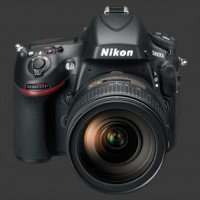
Nikon D800E which uses the same sensor without an anti-alias filter. With a 36 megapixels full-frame sensor, the D800 exceeds the nearest model by 50%. Given its huge advantage, it can produce the largest prints except for considerably more expensive Medium Format cameras.
The Nikon D800 is undoubtedly a professional digital camera. Its sensor can shoot continuously at 4 FPS and capture 1080p HD video. The durable body of the D800 features an extra large 100% coverage viewfinder and weather-seals against dust and moisture.
This high-end digital camera is designed for efficiency with dual control-dials and over twenty direct controls. It also emphasizes video with a sophisticated full-time autofocus system, external stereo sound input and video manual-controls.
The Nikon D800 offers an extremely capable alternative to medium-format cameras at a fraction of the price and will all the flexibility of the Nikon F-mount which boasts one of the two largest lens lineups of the industry.
This detailed digital camera review evaluates the Nikon D800 in terms of features, ergonomics, usability, performance, image quality and controls.
Nikon D800 Key Features
Sensor
- 36 Megapixels CMOS sensor
- Full-Fame Nikon FX format
- Standard ISO 100 - 6400 range
- Expanded ISO 50 - 25600 range
- Customizable Auto ISO
- Built-in Dust-Reduction
- JPEG, RAW or JPEG+RAW Output
- 1920x1080 @ 30 FPS 16:9 HD Video
- 1280x720 @ 60 FPS 16:9 HD Video
Exposure
- PASM exposure modes
- 1/8000s - 30s Shutter-speed, plus Bulb
- EC, ±5 EV, 1/2 or 1/3 EV steps
- FC, -3...+1, 1/2 or 1/3 EV steps
- Matrix (Multi-Segment), Center-Weighed, Average & Spot metering
- AEB or Flash Bracketing, 2 to 9 Frames, ±1 EV
- Exposure Fine-Tuning, ±1 EV, 1/6 EV steps
- ½ or 1/3 EV Exposure & ISO steps
- Built-In HDR, 2 shots, 1-3 EV steps, 3 blending levels, single image or series
- 1/250s Flash-Sync speed
Focus & Drive
- 51-Point Phase-Detect autofocus, 15 cross-type
- Single-Point, Dynamic-Area or Auto focus-point
- Single-Shot, Continuous or Manual focus-drive
- 3D Tracking AF with OVF and Live-View
- Contrast-detect AF for Live-View and video
- Face-Detect AF in Live-View
- Optional AF-Assist lamp
- 4 FPS6 FPS with optional battery-grip. Drive, Max 22 JPEG or 16 RAW
- Customizable Self-Timer, 1-9 Shots, 2-20s Start Delay, ½-3s Interval
- Quiet-Shutter with delayed mirror-return
- Mirror-Up and Exposure-Delay, 1-3s
- Multiple-Exposure, 2-10 shots, optional Auto Gain
- Internal-Timer, 1-999 times, 1-9 shots, 1s-24h interval, delayed start 1m-23h59m
- Time-Lapse, 1s-10m interval, 1m-8h capture time
- Optional Autofocus Fine-Tuning
- Wired remote connector
Images Parameters
- AutomaticTwo types: Normal & Preserve Warm Colors, Preset, Kelvin and Custom4 Memories WB
- White-Balance fine-tuning, 2-axis, 13-steps
- 6 Built-In Picture Styles
- Automatic or Manual Sharpness, 10 steps
- Automatic or Manual Contrast, 7 steps
- Automatic or Manual Saturation, 7 steps
- Manually Adjustable Hue, 7 steps
- Manually Adjustable Tone-Curve, 3 levels
- Virtual WB Bracketing, 2-9 Frames, 3 step sizes
- Virtual ADL Bracketing, 2-5 Frame, 1 step suze
- Optional High-ISO Noise Reduction, 3 levels
- Optional Long Shutter Noise Reduction
- Optional Distortion-Correction
- Optional Vignetting-Correction
- Optional Active D-Lighting (ADL), 4 levels
- Optional Dust-Off reference photo
Controls
- Dual control-dials
- Optional Easy ISO or EC control
- Combined configurable AE-L/AF-L button
- Dedicated AF-On button
- Modeless exposure-mode
- Modal drive-mode dial
- Independent AEB button
- Customizable Function button
- Customizable DOF-Preview button
- Direct Video-Recording button
- Live-View trigger
- Focus-Point lock
Viewfinder & Displays
- 100% Coverage viewfinder, 0.7X magnification
- Built-in viewfinder shutter
- 3.2" LCD, 920K Pixels
- Illuminated top LCD status display
- Dual-Axis Digital-Level
- Optional DOF-Preview in viewfinder
- DOF-Preview in Live-View
- Optional DX cropping frame
- Optional composition grid
- Sound-Level monitor
Body & Construction
- Nikon F-mount
- Weather-sealed body
- Built-in pop-up flash (GN 13)
- Hot-Shoe for external lighting
- Sync-Port for external lighting
- Built-in microphone, 20 levels
- Stereo sound-input mini-jack
- Compact Flash memory card slot
- SDXC Memory card slot
- Proprietary Lithium-Ion battery
- 1080p Uncompressed HDMI output
- Metal tripod mount
Nikon D800 Suitability - What is it good for?
As an advanced DSLR, the Nikon D800 is suitable for every type of photographic subject. Its Nikon lens mount accepts lenses with built-in autofocus motors and those using body-driven autofocus. As a full-frame DSLR, it supports natively all Nikkor FX lenses at its maximum resolution and without crop-factor. It supports Nikkor DX lenses too, albeit at a resolution of 15 megapixels with a 1.5X crop-factor. The viewfinder displays an optional DX frame overly to help compose cropped images. Given that Nikon and Canon produce more lenses than all other camera manufacturers and have the most third-party lenses built for them, lens flexibility is top-notch.
The D800 is ideal for producing huge prints. Its full-frame sensor give it larger pixels than most APS-C cameras while delivering over twice the resolution. It can produce amazingly detailed 20 x 30" prints and make very sharp 24x36" posters. Given a large ISO range of 100 - 6400, expandable to 50 - 25600, this DSLR can be used in very low-light. With a tripod, metered exposures up to 30 seconds combined with high-ISO sensitivities let it capture very dark scenes. This is extended by its Bulb mode which is needed to capture star-trails and moonlit scenes.
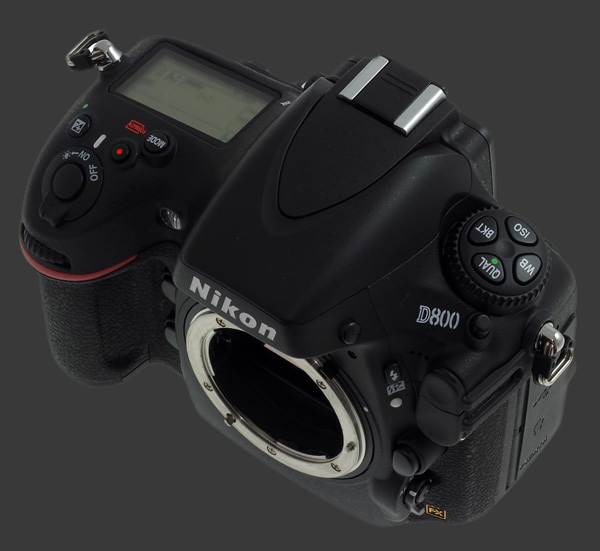
Action photography is well covered by this Nikon. The top shutter-speed of 1/8000s is standard for DSLRs and the 51-point AF system is capable of tracking action using distance and color information as a subject moves. The continuous drive of the D800 shoots at a maximum of 4 FPS although action-oriented models can shoot twice as fast now. The buffer-depth is variable. For the very best quality 14-bit losslessly compressed RAW files, up to 16 images are possible. Switching to highest-quality JPEGs, up to 22 can be captured in a single burst. A maximum of 100 frames is possible with lower image quality.
This digital camera is capable of producing tone-mapped HDR imagesTechnically, the D800 most likely uses Exposure-Fusion. in-camera. In HDR mode, this camera captures two images in quick succession with an exposure differential between 1 and 3 EVs. It then blends the two exposures according to 3 smoothing levels. The images below show the difference between normal (LDR) and HDR images at each smoothing level.
Studio work requires the use of external lighting, which the D800 supports via its hot-shoe or industry-standard Sync-Port. The D800 is also compatible with Nikon's own Creative Lighting System (CLS) and its built-in flash is usable as wireless commander.
Street photography is possible although, like most DSLR cameras, the D800 does not afford much discretion due to its size. Still, this very quick and responsive camera can take the shot and move-on without much fuss. Obviously, all types of still-subject photography such as landscape and architecture are extremely well handled by this digital camera with a suitable choice of lens.
Nikon D800 Capability - What can it do?
As the feature list in the introductions shows, the Nikon D800 has all features expected from a modern DSLR. Since we have described all those features in plenty of reviews already, only things over the minimum or usual functionality is described in this part of the review.
The Nikon D800 has a 3-way power-switch. Two positions are the usual On and Off choices. The third position is spring-loaded and triggers illumination of the top status LCD. Optionally, the status LCD can be permanently illuminated while the camera is On. Even when the camera is off, the status LCD nicely indicates which card is inserted and how much space is available in the first occupied slot.
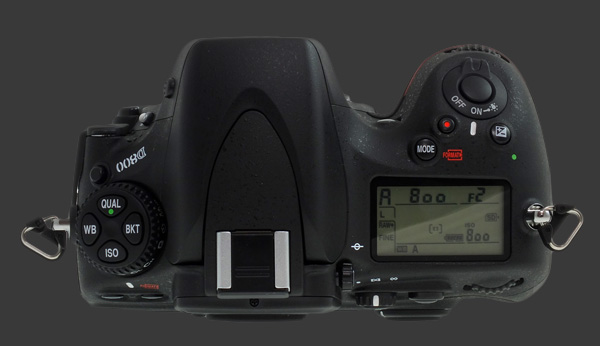
There is no traditional mode-dial on this SLR. Instead, a Mode button offers a selection of PASM modes which are chosen by turning the rear control-dial. There is no full Auto or Scene modes on the D800. Since the choice of exposure mode is modeless, the D800 offers five memory banks which can use any exposure-mode without misleading the user.
This DSLR offers a complete set of drive modes, most of them fairly obvious. There are two continuous modes: CL and CH. CH shoots at 4 FPS6 FPS with optional battery grip. until the memory buffer gets full. CL can be set to between 1 and 4 FPS5 FPS with optional battery grip.. The only unusual mode is Q which stands for Quiet Shutter. It works by moving the mirror very slowly to reduce noise made by the camera. It also does not return the mirror to its up-position until the shutter is fully released. This is useful for times when camera sounds are distracting.
There is one Custom Menu option which should truly be a drive mode: Exposure Delay Mode. This basically a self-timer of between 1 and 3 seconds which raises the mirror up at the beginning of the delay. In fact, without any remote release, this is the only way to prevent camera shake. Too bad this does not have its own position on the drive-mode dial. At best, it can be placed in the customizable menu though.
Interval shooting is set separately from drive modes. Nikon's implementation is the most sophisticated. A start time can be specified, as well as the number of intervals and number of shots to take at each interval. With AEB, this can be used to create an HDR time-lapse. The interval can be between 1s and 24h and number of intervals between 1 and 999. Between 1 and 9 shots can be taken at each interval.
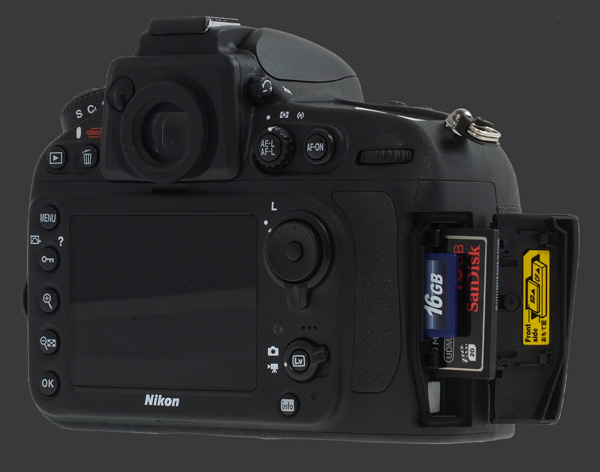
Metering patterns are chosen by a 3-way switch on the rear. There are three choices: Matrix, Spot and Center-Weighed. Matrix is Nikon's name for Multi-Segment metering and Spot is, well, Spot metering. According to a custom setting, the third choice activates Average metering or Center-Weighed. The same option lets the camera use one of four sizes8mm, 12mm, 15mm or 20mm for the central-portion.
The combined AE-L/AF-L button is customizable with some unrelated functions DOF-Preview, Flash Off, Bracketing Burst, Matrix Metering, Center-Weighed Metering, Spot Metering, Playback, Top My Menu Item, +RAW, Virtual Horizon. plus:
- AE/AF Lock - Locks both exposure and focus.
- AE Lock - Locks exposure only.
- AF Lock - Locks focus only.
- AE Lock and Hold - Locks exposure and keeps it locked until pressed again. This is useful when taking multiple shots for stitching panoramas.
- AF-On - Triggers autofocus if neither camera nor lens are set to MF.
- FV Lock - Locks computed flash power.
Bracketing can be enabled for 2 to 9 frames with steps up to ±1 EV. A configuration option controls if flash power is adjusted for the bracket or if virtual bracketing for WB or ADL is performed instead. For WB bracketing, there are 3 step sizes. For WB, only one photo is taken but it is saved two or three times with different white-balance fine-tuning.
The standard ISO range goes from 100 to 6400. Expanded ISO values are given labels instead. ISO 50 is called L 1.0. ISO 12800 is called H 1.0 and ISO 25600 is called H 2.0. When using these expanded ISO sensitivities, Nikon does not store ISO information correctly in EXIF data of image files. The Auto ISO works differently than on other brands of DSLRs. The user can configure a maximum sensitivity and minimum shutter-speed. The D800 then always adjusts the chosen ISO within the permitted range to obtain at least the specified shutter-speed.
White-balance options are plentiful. There are 2 types of Automatic WB. One tries to correct everything, the other leaves warm lighting intact. There are 6 presets and 4 custom white-balance memories. Choosing WB by color temperature in Kelvin degrees is also supported.
This camera features Nikon's Active D-Lighting image processing technology which lightens up dark areas of images to bring out details. There are 4 levels of ADL which differ by how much shadows get boosted. ADL can be manually or automatically set to one of those levels or turned off entirely. ADL indirectly affects RAW capture because exposure is adjusted according to the selected ADL level.
There are two memory-slots on the D800. One accepts Compact Flash Type 1 cards and the other SDXC or compatible cards. Both slots are found under the same weather-sealed door. This digital cameras makes excellent use of both slots, offering several modes of operation:
- Overflow: When one card fills up, start filling the other one. May help buying cheaper cards.
- Backup: Duplicate everything to both cards, ideally using cards of the same size and speed. This is the professional choice in case one card fails.
- Format-Separation: For RAW+JPEG shooters, RAW files are stored in Slot 1, JPEG images in Slot 2.
This DSLR can capture JPEG images or RAW files, using the NEF format. The Nikon D800 can compress RAW files lossessly or not, the latter option saving on average 25% space. RAW data can be saved using 12-bits or 14-bits per pixel. Obviously, the latter is more precise but consumes roughly 20% more space.
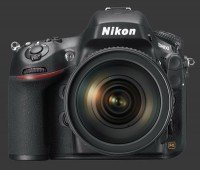 |
Please Support Neocamera
All information on Neocamera is provided free of charge yet running this website is a huge endeavor. Purchases made via affiliate links found throughout the site help keep it running and up-to-date. There is no additional cost to you, so please consider buying via these links to our affilates:
If you found any information on this site valuable and did not purchase via our affiliate links, please considering donating via PayPal:
Any amount will be greatly appreaciated. Thank you for your support!
Nikon D800 Highlights

Sensor-Size: 36 x 24mm

Actual size when viewed at 100 DPI
| 36 Megapixels DSLR | ISO 50-25600 |
| Nikon F Mount 1X FLM | Shutter 1/8000-30s |
| 100% Coverage Extra Large Viewfinder | Full manual controls, including Manual Focus |
| 2 Axis Digital Level | Custom white-balance with 2 axis fine-tuning |
| Weatherproof | Spot-Metering |
| Built-in Dust Reduction | Hot-Shoe & Sync-Port |
| 4 FPS Drive, 22 Images | Stereo audio input |
| 1920x1080 @ 30 FPS Video Recording | Lithium-Ion Battery |
| 3.2" LCD 920K Pixels | Secure Digital Extended Capacity, Compact Flash Type 1 |
Updates
2025.01.18

Fujifilm GFX 2025 Lens Roundup
Lens Review roundup of Fujifilm GFX Medium-Format lenses. Quality, performance and handling of the GF20-35mm F/4R WR, GF30mm F/3.5 Tilt-Shift and the GF55mm F/1.7.
2024.11.18

Best 2024 Photography Gifts for Every Budget
Great gifts for photographers and photo enthusiasts selected for every budget among the best products of 2024.
2024.08.07

Eye Protection Tips for Professional Photographers
The four main considerations for professional photographers regarding eyewear.
2024.07.14

Fujifilm X100VI Review
Flagship fixed-lens compact digital camera with a 40 MP sensor and Image-Stabilization, a first for the series. Retro design featuring dual control-dials, plus direct ISO, Shutter-Speed and EC dials. Its hybrid viewfinder can switch between EVF and OVF mode.
2024.05.09

Fujifilm GFX100 II Review
Flagship 102 Megapixels Medium-Format Mirrorless Digital Camera with 8-Stop 5-Axis IBIS, 8 FPS Drive, 8K Video and 400 MP Super-Resolution capture in a weatherproof and freezeproof body with dual control-dials and dual memory-card slots.
2024.04.03

Fujifilm X-T5 Review
Newest Fujifilm flagship boasting a 40 MP APS-C sensor, 5-axis IBIS with 7-stop efficiency, 15 FPS continuous drive, 6.2K Video capture, dual control-dials and dual SDXC UHS-II slots in a sturdy weatherproof and freezeproof body.
2023.11.20

Best Digital Cameras of 2023
Find out which are the Best Digital Cameras of 2023. All the new Mirrorless Digital Cameras from entry-level to high-end professional.
2023.07.10

Fujifilm X-H2 Review
40 Megapixels APS-C Hybrid Mirrorless Digital Camera with 7-stop IBIS. Fastest shutter ever and 8K video capture. Large builtin EVF with 0.8X magnification and 5.8 MP, plus an Eye-Start Sensor. Packed with features and large number of controls in a weatherproof and freezeproof body.
2023.05.07

Sony FE 20-70mm F/4G Review
Review of the unique Sony FE 20-70mm F/4G lens. The optical zoom of this lens spans ultra-wide-angle and medium focal-length coverage, making it one of the most versatile Full-Frame lenses on the market.
2023.01.15

Huion Inspiroy Dial 2 Review
Review of the Huion Inspiroy Dial 2 tablet, a medium sized drawing surface with dual dials and customizable buttons. Connects via USB-C or Bluetooth 5.0 with Windows, Linux and Android support.
2022.12.08

How to Pack for a Photo Trip
Find out how to pack for a travel photography trip, carry your gear safely while meeting airline regulations.
2022.11.13

Best Digital Cameras of 2022
The best digital cameras of 2022. A short list of the most outstanding models in their respective categories. Choose one for yourself or as a gift.













